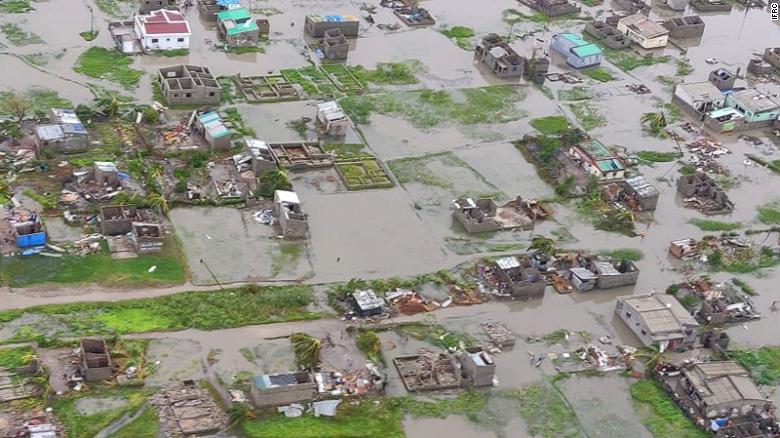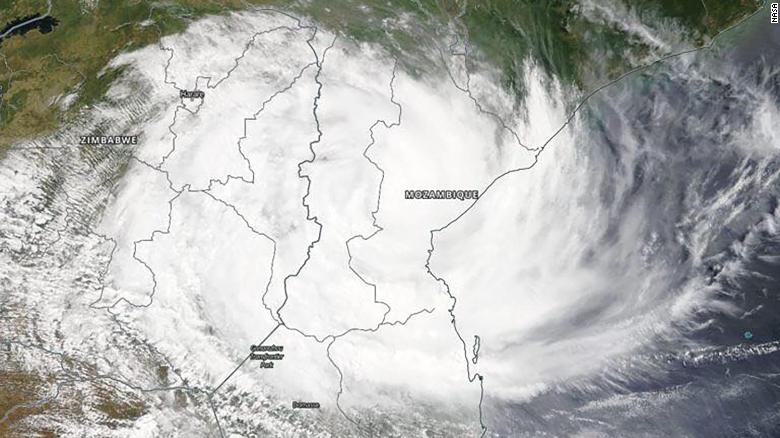Tropical Cyclone Idai ripped through Mozambique as a high-end Category 2 storm with 175 kph (110 mph) winds last week before moving inland into Zimbabwe and Malawi, affecting 1.5 million people in its wake.
Aid agency officials have said that 90% of the Mozambique city of Beira has been "destroyed" by the cyclone, warning that more than 500,000 people there have been impacted.
While the official death toll stands at 84 in Mozambique, it's expected to rise significantly. On Monday, President Filipe Nyusi said that "everything indicates that we can have a record of more than 1,000 dead."
If that estimate is confirmed, Idai would be the deadliest tropical cyclone on record to hit anywhere in Africa.
 |
| Cyclone Idai Could Be The Deadliest Tropical Cyclone to Hit Africa. Here's What You Need to Know |
As we learn more about its devastating path, here's what you need to know.
How does Cyclone Idai compare to recent super storms?
How does Cyclone Idai compare to recent super storms?
Around midnight on Thursday night, the tropical cyclone made landfall as an equivalent borderline Category 2/Category 3 storm on the Saffir-Simpson hurricane scale, with maximum winds at around 175 kph. This is close to the same intensity that Hurricane Irma had when it hit Florida in 2017, which was 185 kph.
Irma spent three days as a Category 5 hurricane, the longest Category 5 hurricane since satellite storm-tracking began. At a total of 37 hours, no storm on record has maintained winds 185 kph or above for as long as Irma. It prompted the largest evacuation in the history of the Bahamas -- and potentially the largest in the US.
Tropical Cyclone Idai's winds reached peak intensity of 195 kph (Category 3 on Saffir Simpson scale) on March 14 -- but unlike Irma, which weakened significantly before hitting the US, Idai made landfall less than 24 hours after reaching its peak intensity.
 |
| A NASA aerial image shows Cyclone Idai on Wednesday, prior to making landfall. |
You just compared a tropical cyclone to a hurricane. Is there any difference between the two?
Nope. Hurricanes and tropical cyclones are the exact same thing -- they just have different names depending on the part of the world in which they occur.
In the southern hemisphere, these storms spin in the opposite direction from hurricanes and typhoons in the northern hemisphere.
How common are typhoons in Mozambique?
Tropical cyclones hit Mozambique rarely, but are not unusual. They get a hurricane strength storm -- with winds greater than 120 kph -- a couple times per decade, on average.
Idai was the strongest tropical cyclone to hit the country since 2008, when Tropical Cyclone Jokwe, which had maximum winds of 185 kph, made landfall.
Tropical Storm Eline struck the same region in 2000 and killed around 800 people. Eline, which had winds equivalent to a Category 4 hurricane when it hit, is currently listed as the deadliest African tropical cyclone -- or anywhere in the southern hemisphere.
However Idai is already one of the deadliest storms to ever strike anywhere in the southern hemisphere and it could end up topping that list.
Will Tropical Cyclone Idai be the biggest storm this year?
That's unlikely. There will probably be 10 or more storms this year on the planet that cultivate stronger (higher winds) than Idai.
We are still months away from the global peak of hurricane/typhoon season for the planet, which happens in the northern hemisphere, where a majority of the earth's tropical cyclones occur. That season begins in late summer/early fall.
What you should know about hurricanes 01:07
However, when you combine the flooding rainfall before Cyclone Idai formed -- during the storm and then after landfall -- few storms will likely have the same impact it did in southern Africa.
And while Idai's impact has been devastating, this storm doesn't come anywhere near a record for the world's "strongest or biggest storms."
In 1979, Typhoon Tip, a hurricane with a diameter measuring the distance between New York and Dallas, Texas, measured speeds of 300 kph per hour. It did not however, make landfall.
Why did Idai have such a devastating impact on Mozambique?
The coastal city of Beira, Mozambique, which was ground zero for the cyclone's landfall, is very vulnerable to storm surge due to its low-lying location.
Much of the city was likely inundated by the storm surge running ashore. The storm surge, which measured by the height of the ocean above normal at the coastline, has been estimated to be more than 4 meters (almost 15 feet) in the case of Tropical Cyclone Idai.
The scale of damage caused by Tropical Cyclone Idai is seen in Mozambique's Beira on Sunday.
Think of New Orleans in 2005, during Hurricane Katrina, to give you an idea of what a strong storm can do to a low-lying coastal city in a direct hit.
Katrina, a Category 3 storm with winds near to 204 kph, produced storm surges that breached the levees around New Orleans, leading to catastrophic flooding in the city. It also caused flooding damage to cities along the Gulf Coast, from New Orleans to Biloxi, Mississippi.
Compared to other parts of the world, Mozambique is certainly more vulnerable to disasters like Cyclone Idai. However, the combination of tremendous amounts of rain before, during and after the storm -- combined with the storm surge and winds from the cyclone -- would result in a major disaster anywhere.
Look no further than 2017's Category 4 Hurricane Harvey, which busted the US record for rainfall from a single storm at the time, dumping 51 inches of rain in parts of Texas.
Some 30,000 people were in need of temporary shelter, while economic losses were estimated at as much as $75 billion.
Tropical rainfall and storm surge can combine to have devastating flooding with long-term effects on infrastructure and economy.
Did climate change play a part in this?
Put simply, yes. Warmer air and waters result in more moisture in the atmosphere that is available for storms.
And as we saw with Hurricane Harvey and last year's Hurricane Florence, climate change is resulting in more abundant rainfall-producing tropical cyclones and hurricanes.
Mozambique ranks as the third most vulnerable nation in Africa to climate change due to its susceptibility to extreme weather such as floods, droughts and cyclones, according to the Global Facility for Disaster Reduction and Recovery. - CNN
Adverts Here














